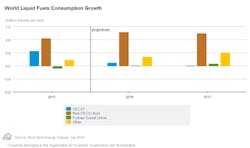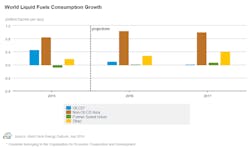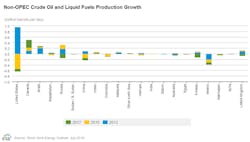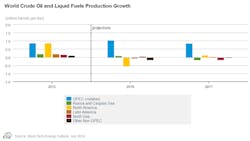EIA: Latest STEO forecasts oil market balancing in 2017
Global inventory builds of petroleum and other liquid fuels will average 900,000 b/d in 2016, slowing down from 1.9 million b/d in 2015, according to the July Short-Term Energy Outlook from the US Energy Information Administration. EIA also expects the market to reach balance in 2017, with inventory draws during the second half of the year averaging 300,000 b/d.
EIA now expects global oil consumption to increase 1.4 million b/d in 2016 and 1.5 million b/d in 2017, little changed from the forecast in the June STEO (OGJ Online, June 7, 2016). The growth is mainly driven by countries outside the Organization for Economic Cooperation and Development.
Non-OECD consumption growth was an estimated 1 million b/d in 2015, and it is expected to be 1.3 million b/d in 2016 and 1.5 million b/d in 2017, according to EIA.
“This forecast reflects an upward adjustment to India’s consumption growth in 2016 and 2017 of about 100,000 b/d, raising the country’s growth to 400,000 b/d annually, mainly as a result of increased use of transportation fuels and of naphtha for new petrochemical projects. China’s consumption of petroleum and other liquid fuels is forecast to grow 400,000 b/d in both 2016 and 2017, driven by increased use of gasoline, jet fuel, and hydrocarbon gas liquids (HGL), which more than offset decreases in diesel consumption,” EIA said.
Consumption of OECD petroleum and other liquid fuels rose 500,000 b/d in 2015 and is expected to increase 200,000 b/d in 2016 and less than 100,000 b/d in 2017. Consumption growth in the US and South Korea more than offsets decreases in consumption in OECD Europe and Japan in 2016 and 2017.
This forecast also includes a slight downward adjustment to petroleum and other liquids fuels consumption in OECD Europe in 2017 as a result of uncertainty related to the UK’s vote last month to leave the European Union. However, EIA expects that the effect on oil consumption in the forecast period will be largely limited to Europe.
Non-OPEC supply
EIA expects production outside the Organization of the Petroleum Exporting Countries to decline 600,000 b/d in 2016 and 200,000 b/d in 2017, with most of the production declines occurring in the US. Non-OPEC production rose 1.6 million b/d in 2015, driven by the growth in North America.
Forecast total US production of liquid fuels declines 500,000 b/d in 2016 and 100,000 b/d in 2017, as declining crude oil production is partially offset by expected growth in HGL production, Gulf of Mexico crude oil production, and liquid biofuels production.
Outside of the US, forecast non-OPEC production declines 100,000 b/d in both 2016 and in 2017. “Although oil companies have reduced investments, most of the cuts have been to capital budgets that largely affect production levels beyond 2017,” EIA said.
Among non-OPEC producers outside the US, the largest declines in 2016 are forecast to be in China, while the largest declines in 2017 are in the North Sea and in Russia.
Non-OPEC unplanned supply outages in June were 700,000 b/d—a decrease of 400,000 b/d from the May level—as Canadian oil sands production gradually return from wildfire-related outages that began in May. In June, Canada’s unplanned outages averaged 400,000 b/d, about half of the May level.
OPEC supply
Gabon rejoined OPEC as of July 1, following a 21-year hiatus from the organization. Gabon currently produces more than 200,000 b/d of crude oil.
With the inclusion of Indonesia and Gabon, OPEC crude oil production averaged 31.8 million b/d in 2015, an increase of 800,000 b/d from 2014, led by Iraq and Saudi Arabia. According to the July STEO, OPEC crude oil production will rise 800,000 b/d in 2016, with Iran accounting for most of the increase. Forecast OPEC production rises by an additional 500,000 b/d in 2017, as major OPEC producers are expected to continue their strategy of maintaining market share.
OPEC non-crude liquids production averaged 6.6 million b/d in 2015, and it is forecast to increase by about 300,000 b/d in both 2016 and 2017, led by Iran and Qatar.
Crude oil prices
North Sea Brent crude oil prices averaged $48/bbl in June, a $2/bbl increase from May and the fifth consecutive monthly increase since reaching a 12-year low of $31/bbl in January.
Brent crude oil prices are forecast to average $44/bbl in 2016 and $52/bbl in 2017. West Texas Intermediate crude oil prices are forecast to be the same as Brent in 2016 and 2017.



